Building a more sustainable world, one pallet at a time
Our vision is a world where supply chains produce zero wood waste, with a minimum negative impact on our climate and ecosystems.
Our Sustainability Strategy
To achieve our sustainability vision, Kamps has made significant investments at all stages of our “Sustainable Pallet Life-Cycle” to ensure we have the most comprehensive supply chain coverage for our customers and vendors. This ability allows us to continuously retain the maximum amount of pallets in inventory, while creating value out of “End of Life” pallets via environmentally positive by-products such as Mulch, Biofuel, and Wood Pellets.
Through our Green Scorecard Certificate, Kamps passes this positive impact along to our customers and vendors.
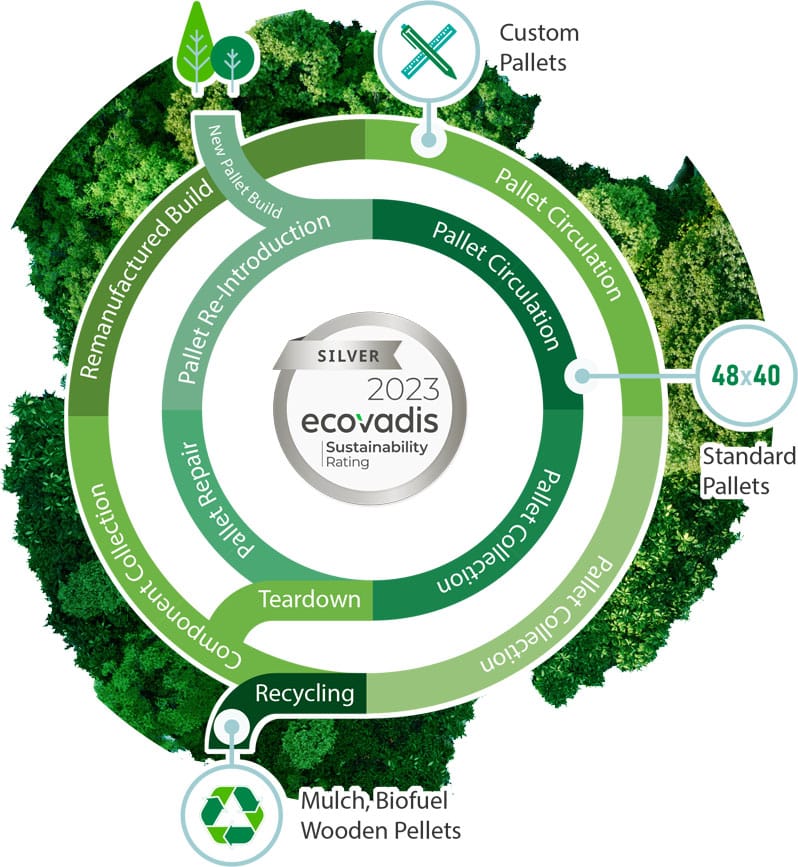
2023 Corporate Social Responsibility Report
The world around us continues to change, find out how Kamps' innovative spirit is helping us meet sustainability goals and how we can help your organization reach its own.
Report highlights are featured below.
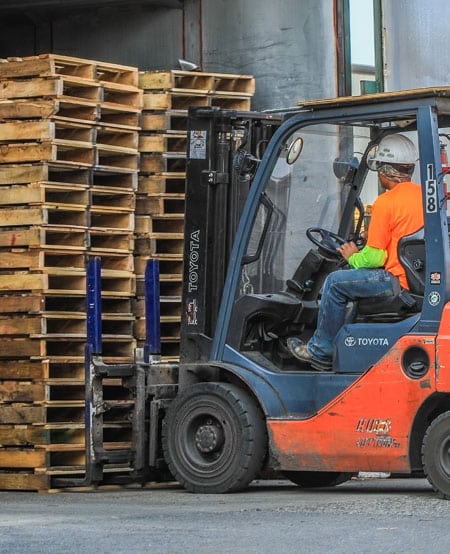
While recognizing the size and scale of our business operations, Kamps conducted a carbon footprint assessment to understand our carbon impact. Our operational carbon footprint analysis revealed that during the calendar year 2023, Kamps emitted 64,978 metric tons of CO2-e.
In previous years, we calculated electricity usage based on spend and used approximations to calculate usage. For 2023, we made a conscious effort to improve the accuracy of our data and worked with utility partners to access exact usage numbers for our locations. For our mobile sources calculations, we also transitioned away from EPA guides and instead used Greenhouse Gas Protocol tools, a more widely used greenhouse gas accounting standard globally.
To paint a true picture of our carbon emission offsets in relation to our footprint, Kamps also conducted a carbon handprint analysis specific to our company-owned facilities, considering pallet life-cycle usage – using the 2020 UL Certified EPD as guidance.
Kamps utilized the latest research available to calculate the baseline emissions associated with manufacturing virgin pallets and assumed that a new wooden stringer pallet would last approximately 24 trips. Based on Kamps’ refurbishment process, it has been assumed that a remanufactured pallet (i.e., a pallet built from ‘like-new’ components) and a refurbished like-new pallet (i.e., a pallet that requires minimal repairs) will have the same trip life as a new wooden pallet and that a refurbished pallet will last half the trip life of a new pallet. Kamps has estimated that by recycling 202M+ pallets through our Kamps-owned and operated facilities in 2023 (which displaces the need to procure a new pallet) and forecasting over a 24-trip period, which represents the useful life of a new wooden pallet, our business contributes to the avoidance of over 862,750 metric tons CO2-e of GHG emissions over this timeframe. By producing close to 1M cubic yards of mulch from scrap pallet pieces, Kamps avoided approximately 3,000 metric tons CO2-e of GHG.
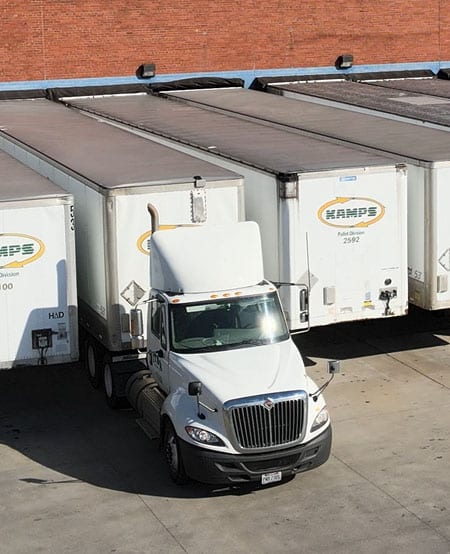
The analysis of our carbon footprint by source revealed that more than half of our operational carbon footprint can be attributed to fuel consumption associated with Kamps Logistics fleet operations. To lower these emissions, Kamps Logistics has partnered with a national communications and SaaS company to track fleet performance to help with route optimization. In 2021, the overall route time decreased by 15%. In 2022 the overall route time increased by 1.63%, however, total miles traveled by also increased by ~80%.
Kamps investigated the reasons for the increase in overall route time. Our findings were that the majority of the increases came from newly acquired locations in their first 1-3 years utilizing Kamps Logistics. Expanding our geographic area of service and increasing the number of pickups and deliveries also played a significant role.
For example, our overall pickups and deliveries increased by 32%, while our overall route time only increased by 1.63%. Kamps expects our strategy of comprehensively integrating acquired locations onto Kamps systems and standards to yield positive results in the coming years. We also intend to investigate additional ways in which we can economically reduce our footprint.
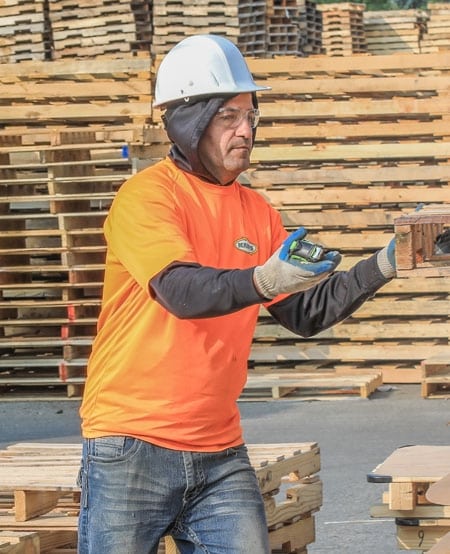
Our Sustainable Pallet Life-Cycle contributes to millions of metric tons of CO2 emission prevention. This is because the amount of carbon that is emitted during the process of repairing or remanufacturing a pallet is significantly lower than building a new pallet. Kamps’ carbon offset strategy is largely driven by this difference, with a focus on extending the life of a pallet to its maximum potential through minimal carbon emissions. The second component of our carbon offset strategy is landfill avoidance for our scrap and end-of-life pallets. By finding an environmentally sustainable alternative to these pallets, Kamps offsets carbon emissions that are in accordance with EPA’s WARM model. In 2022, Kamps recycled over 392 million pallets across all locations. This volume includes the Kamps national network, as well as historical annual data for acquired locations post-Kamps acquisition and pooled pallet repair facilities
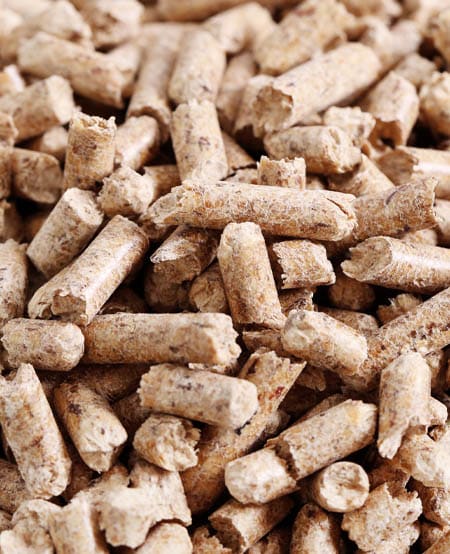
Kamps seeks to extend the life of our products as much as possible while finding the most environmentally friendly “End of Life” disposal process. One of our strategic “End of Life” disposal processes is the creation of Green Energy (i.e. renewable sources such as Biofuel). To achieve this, we transfer ground scrap pallets to co-generation plants that power municipalities, schools, and more. As an example, one of the co-generation plants that accept our Biofuel in Michigan can produce approximately 650 kWh of energy per ton of Biofuel, resulting in over 27,039 MWh of energy produced in 2023.
A secondary source that produces energy is our wooden pellet products. Wooden pellets are a low-carbon heating alternative to charcoal, natural gas, and heating oil.
Our wooden pellets are created from scrap pallets and wood waste that arrives or is generated in our facilities. Because our pellets are manufactured from these sources, research shows that they have a carbon benefit when compared to common fossil-derived fuel sources, with each production scenario delivering at least a 65% reduction in carbon intensity.
In 2023, Kamps produced over 70,000 tons of wooden pellets, which creates enough energy to heat 24,000 homes for an entire year.

392,000,000 Pallets Recycled
These figures represent 2023 numbers, video above includes 2021 figures.

0
Trees Saved
0
Tons of landfill diverted
0
mt of CO2 savedOur Green Scorecard Certificate
Kamps has pinpointed three major environmental impacts of our pallet recycling operations.
These environmental impact factors make up the basis of our Green Scorecard Certificate, a certificate that tracks these factors through the following environmental KPIs: Carbon Off-Sets, Landfill Diversions, and Trees Saved. Every pallet that we recondition, repurpose, or grind into mulch is recorded and its impact on our environment is reflected.
As a trusted partner and supply chain contributor, Kamps appreciates the role we play in our customers' and vendors' environmental reporting. That is why we leverage this data to provide our customers with their own Green Scorecard Certificates, based on their annual impact with Kamps. This data includes carbon off-set data applicable to Scope 3 reporting.
Total Number Recycled: Based on Kamps national network, including historical annual data post Kamps acquisition. | Trees Saved: Based on first-hand proprietary research performed by Kamps using lumber source data and internal manufacturing data. | Landfill Diverted: Assumes 18.5 kilograms per pallet on average and 100% of the pallets recycled would have otherwise been landfilled. | Carbon Off-Sets: Based on Version 13 of EPA’s WARM model for dimensional lumber.

